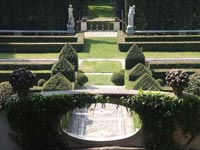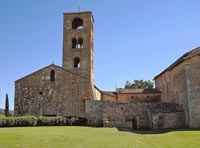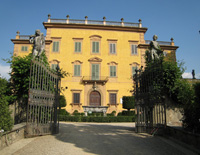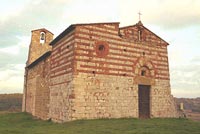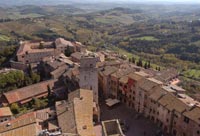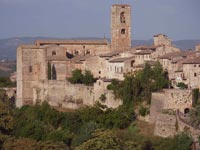Il Palazzone |
| The impressive and princely villa was owned by Silvio Passerini (1496-1529). A follower of the Medici family, under their influence he began a brilliant career, which, however, was to result in misfortune in the final years of his life.
The plans for the villa were undertaken by the painter, architect and poet Giovan Battista Caporali (1476?-1560?), pupil of Perugino, a friend of the great artists of the period and teacher of Galeazzo Alessi. The interior decorator, perhaps in conjunction with Caporali himself, was Tommaso Bernabei, otherwise known as `Il Papacello' (+1559), famous for being Signorelli's best scholar and for having worked in Rome with Giulio Romano and later, in Perugia, at the Palazzo dei Priori. The villa is splendidly positioned halfway down the slope, approximately at an equal distance from Cortona and S. Angelo a Metelliano. Viewing it from the outside, the visitor will find it hard to believe that the villa was constructed in the sixteenth century, as the style of the building, particularly the tower with its double battlements, evokes the middle ages, and the overall effect is that of a small fortress rather than of a villa. Its belated style lends the villa a particular dignity and suggests solidity and unity: dominating and austere, it is without embellishments. The building covers an area of 856,280 square metres, measuring 70 metres in length and 27 in breadth. The height of the tower is 48 metres, the drawing room is 15 by 7.20 metres, and the courtyard, with a portico and an elegant renaissance well, measures 17 by 10 metres. A spiral staircase leads to the grand stone doorway that bears the coat of arms of the Passerini family (of which the upper section houses the insignia of the Medici family) sculpted in its keystone. The interior of the villa is similarly understated and awesome, yet its architecture is more developed. The ground floor was largely reserved for the stables. The main living areas are on the top floor: the drawing room, the Billiards room, the Cardinal's room and the chapel. Of these the drawing room is the most prestigious. The upper walls are decorated with 16 2-metre squared frescoes by Papacello, depicting episodes from Roman history and legend. On the lower walls are painted 16 stunning trompe-l'oeil, remarkable for their verisimilitude, fugues of pillars and background landscapes, and for their visual effect and warm tonalities. The Cardinal's room is situated at the back, to the east, and is decorated with a trompe-l'oeil of pillars and rural scenes. The centre of the ceiling depicts Apollo on his cart and four horses, surrounded by the signs of the zodiac and the four seasons. The furnishing of the Palazzone consists of numerous and noteworthy pieces of furniture and artwork: paintings (originals and copies), settles, sixteenth century wardrobes and chairs, mirrors, knick-knacks, clocks, fine beds and sofas, etruscan urns and all kinds of curiosities. Nor should one forget the beautiful inner courtyard with its renaissance portico and central well. An Italian style garden with an open portico can be found behind the building. The chapel reveals the last work of L. Signorelli, The Baptism of Jesus, a fresco which the great artist was unable to complete, because he fell from the scaffolding whilst painting. The work was completed by his apprentices. The building was recently donated by count Lorenzo Passerini and today belongs to the Scuola Normale Superiore. Location: Il Palazzone is located outside the old town massive walls of Cortona, but still at walking distance (1 km) from the town center. |
| The only building belonging to the Scuola Normale Superiore which is outside Pisa is in the Arezzo province. Located in the city of Cortona, it is called the Palazzone, and it contains a center for academic activities, for conferences and for the University Orientation Courses.
The elegant Renaissance villa and the vast farmland around it were donated to the Scuola Normale in 1968 by Count Lorenzo Passerini of Cortona. He was a descendent of Cardinal Silvio Passerini (1469-1529), Bishop of Cortona, who had the stately building constructed as evidence of the power obtained by his own noble family, which had remained loyal to the Medici dynasty. Passerini, protected when he was young by Lorenzo il Magnifico, and then by Giovanni, future Pope Leone X, was governor of Florence, ambassador of Perugia and tutor regent of the nephews of Clement VII. The construction of the villa was commissioned at the beginning of the 16 th century; the artist chosen was the architect and painter Giovanni Battista Caporali, pupil of Perugino. The decision to locate the villa outside the town, near a spring called “Cumula”, on a hillside of olive and cypress trees, lead to the choice of a fortified structure with a 42-meter-high tower and an impressive battlement wall from which the Trasimeno Lake can be seen. The interior is composed of a spacious, arcaded courtyard with a central well. Opposite the courtyard from the entrance there is the Chapel, with Luca Signorelli's “Baptism of Christ”, in unfortunately bad condition. Vasari wrote of this painting that Signorelli “was not able to finish it because he died while he was working on it”. On the ground floor there is also the “Sala del Papacello”, named for the local painter who frescoed it, Tommaso Bernabei, called the Papacello and pupil of Giulio Romano. His choice of colors was sometimes uneven, but his narrative technique was very lively: he painted a cycle of Roman Histories, from the Battle of the Trasimeno to the one between Orazi and Curiazi, to the heroic deaths of Lucrezia and Virginia. On the other side of the building there is the Cardinal's hall, frescoed in 1819, from which one can reach the Renaissance gardens with a central pond and Etruscan sarcophagi. On the floor above, besides the rooms for the student guests, the old laundry drying room has been converted into a large hall for relaxation and recreation.
Holiday homes in the Tuscan Maremma | Podere Santa Pia
|
|
Spectacular panoramic scenery in Podere Santa Pia, with views that stretch all the way to the Mediterranean sea and the islands of Montecristo and Corsica
|
|
||||
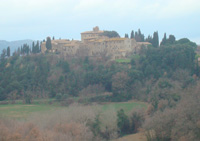 |
||||
Podere Santa Pia |
Podere Santa Pia, view from the garden on the valley below |
Castel Porrona, a charming medieval village dating back to the 11th century, between Cinigiano and Castiglioncello Bandini and Podere Santa Pia | ||
Villa I Tatti |
Sovicille, Pieve di San Giovanni Battistaa Ponte allo Spino |
Villa La Pietra, near Florence |
||
Pieve of SS. Ippolito and Cassiano |
San Gimignano, view from Rocca di Montestaffoli |
Colle di Val d'Elsa |
||
|
||||




